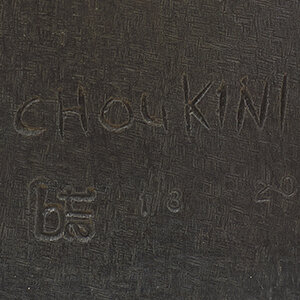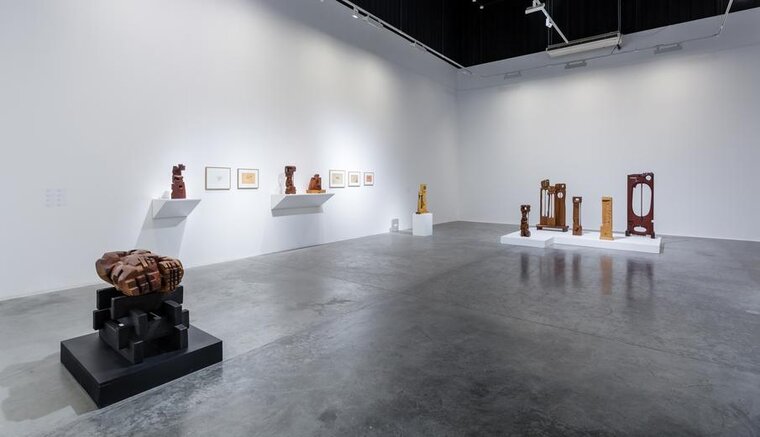


Last updated on Sun 18 September, 2016


POETRY IN WOOD
CHAOUKI CHOUKINI
September 18, 2016 - October 30, 2016
Green Art Gallery is pleased to present an exhibition of sculptures and drawings by Lebanese artist Chaouki Choukini, spanning from the 1970s to the present day.
There’s poetry to be found in wood; a certain lyricism in the smooth expanses of polished grain, and the way myriad shapes unfurl themselves and come to life under the expert movement of the artist’s hand. Smooth planes give way to jagged ridges, and small, deft gouges are etched into soft wood like nicks and cuts in skin. Elsewhere, the flesh of the wood itself glows in rich tones, a sunburst of pale yellow graduating to deep, cherry brown. For France-based Lebanese artist Chaouki Choukini, sculpture offers a window back to what he refers to as the ‘landscape of childhood’, to people and places, and to memories of South Lebanon.
The works within Poetry in Wood [1972-2016] span some four decades, and present an impressive cross-section of Choukini’s ever-evolving sculptural practice. At times displaying Cubist overtones, at others resembling giant Kufic script folded in on itself, Choukini piles block upon block on top of each other, creating cityscapes and mountains, and revealing abstracted, silent faces. Wooden surfaces alternate between smooth, sanded and polished planes and the scars of long, thin gouges and rough chipped surfaces, like tribal markers tattooed into skin. Elsewhere, he whittles shapes down to lines so thin it seems impossible they don’t snap. They resemble the long strings of a bow, drawn out in infinite music and into perfect tension.
It is this tension – between corners and edges, form and function, and, most importantly, positive and negative space – that has come to define Choukini’s work. Each carved piece of wood exists in a delicately balanced dance, an exquisite counterpoint. This juxtaposition of space – this use of nothing – is integral to Choukini’s sculptures. In a nod to Japanese minimalism (after all, he did spend time there in the 1980s), the process of creation requires an element of destruction: he removes, rather than adds, to each piece. He lets in light, and light in turn becomes an integral part of the sculpture, an extra medium with which to play and manipulate the wood itself. It challenges each piece’s relationship with the space it occupies, for it is no longer a dense invader, but rather, woven into the very fabric of the air itself. The process often begins with a sketch, which each sculpture first coming to life on paper before Choukini begins it in wood, and he will always finish a piece to near completion before moving onto another. At times, the process can take years, with the artist revisiting a sculpture long after, to finally give it its final touches. Their titles betray their inspirations, Claire de Lune, Chardon (thistle), Colonnes (column), Tournesols (Sunflowers) and the Pavillon de lumière et d'obscureté a mixture of nostalgia, longing, celebration and curiosity of the world around him.
Indeed, light and space are also evident in Choukini’s delicate watercolour works, and it is here that his sculptures find their counterpoints. Shimmering visions of desert cityscapes are revealed through the haze, drawing on music, memories of places, remote villages and the vast desert itself. Here, light does not peak through folds of wood, rather, each creation is bathed in it. While the shapes – a confluence of cubes and blocks that comprise his citadelles – are familiar. Here, in contrast to the strength of wood, we see delicate watercolours, blurry shapes, applied and erased, making us squint to see it through the fog of memory. Yet these are also studies for the sculptures that surround them in the gallery space – deft visions before they were brought to life in space. They evoke shimmering translucent cities, hovering on the edge of a mirage, slowly revealing themselves to us through layers of swirling sand storms and cloud, unfurling themselves on the page before coming to life in front of our eyes. They are extraordinary visions, places existing within the artist’s memory – part constructivist patchwork, part living being, part elusive dream.
Chaouki Choukini
Born in 1946 in Choukine, Lebanon, Chaouki Choukini received his degree from Ecole Nationale Superieur des Beaux-Arts, Paris. He was awarded the Prix for Young Sculpture in 1978 followed by the Taylor Foundation Prize in 2010. Choukini taught sculpture in both The Lebanese University of Tripoli and The Jordan University of Yarmouk. Since then he lives and works in Paris, France.
He has participated in various shows including Portrait of The-Non-Existent-Bird, Museum of Issoudun, France (2014); Arab Modernities, Espace Claude Lemand, Paris, France (2014); Tajreed (Arab Abstract Art), Contemporary Art Platform, Kuwait (2013); Le Corps decouvert, Arab World Institute, Paris, France (2012); International Aswan Sculpture Symposium, Cairo Biennial, Egypt (1997); Paris Sculpture, Centre de Sculpture Contemporaine, Paris, France (1973). His works are in major collections including Musee d’Art Contemporain de Cal de Marne, France; Arab World Institute, France, Mathaf, Arab Museum of Modern Art, Doha and Centre National Des Arts Plastique, France
Join us in our endless discovery of modern and contemporary Arab art